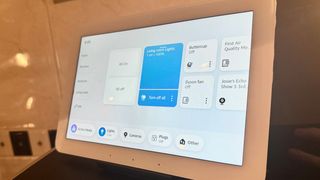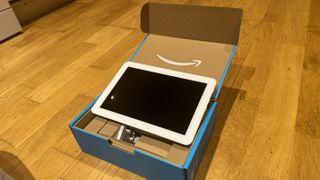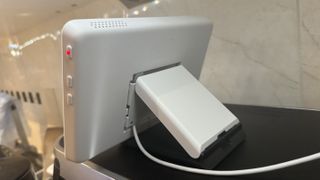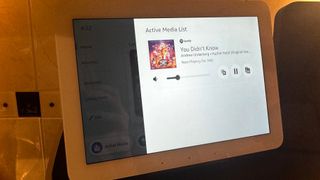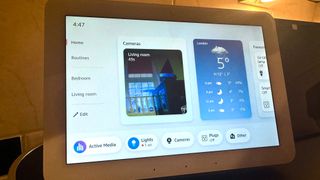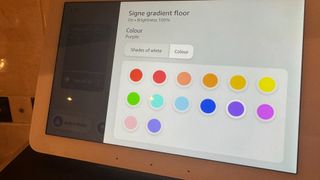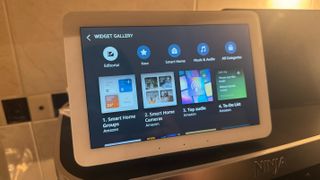Amazon Echo Hub review: Alexa finally puts smart home first
Amazon Echo Hub: Two-minute review
I’m a huge Amazon fan when it comes to smart home products. ‘The variety of devices, and their affordability, the way they seamlessly with one another, and their seriously impressive Alexa capabilities won me over as soon as I started getting into smart home technology, and there’s a reason why Echo devices feature prominently on our list of the best smart speakers.
Overall, Amazon’s smart home devices offer excellent performance across the board, except for one vital area: smart home control. Don’t get me wrong, Alexa is a strong contender for the best smart home ecosystem, but generally speaking, control functions are the most under-serviced aspect of Amazon’s entertainment-first smart speakers and displays – or at least it was until the release of the Amazon Echo Hub.
It’s an interesting move from Amazon; the Echo Hub blends some great features and functionalities that are already found in other Echo devices but adds a more sophisticated and stripped-back UI and some quality-of-life adjustments that make it one of the most attractive products in Amazon’s range of smart home controllers, and certainly one of the best smart displays available now – and I think that’ll be especially true for people who aren’t already onboard with Alexa-enabled devices.
In part, it’s due to the device’s design and UI, which feel distinctly more Google than Amazon. At a time when we’re potentially witnessing a slow and very quiet demise for Google’s smart home products, that’s a real boon for Amazon, and features like the soon-to-be-released Map View will also serve to delight smart home fans.
The product design sees Amazon leaning even further out of its comfort zone; it’s inoffensive but doesn’t look cheap, which is certainly more my speed compared to the Amazon Echo Pop I reviewed last year.
The whole purpose of the Echo Hub feels distinctly more techie, which will likely appeal more to smart home enthusiasts than the more entertainment-led Echo Show devices. Plus, with Matter, Thread, Zigbee, and Bluetooth support, and power-over-Ethernet possibilities, it’s got a lot to offer owners of homes with a large number of connected devices.
It’s a smart move from Amazon to create a true smart-home hub, and it’s also executed it pretty well. Despite some slightly laggy and glitchy interactions with the UI, which I hope will be resolved over time, overall I had a great experience with the Echo Hub.
Amazon Echo Hub: Price and availability
- How much does it cost? $179.99 / £169.99 / AU$329.00
- When is it available? Available now
- Where can you get it? Available in the US, UK and Australia
The Amazon Echo Hub was released in February 2024, and costs $179.99 / £169.99 / AU$329.00. It’s available directly from Amazon; it’s not yet listed at third-party retailers.
Considering that it’s comparable to the Echo Show 8 in size and specs, I was a little surprised initially to discover that the Echo Hub is more expensive. The Show 8 comes in at $149.99 / £149.99 / AU$229, despite offering superior speakers to the Hub, a built-in camera, and great streaming chops; however, it’s just not capable of running a smart home as speedily and responsively as the Echo Hub is.
That’s because while the Echo Hub uses the same baseline OS as the recent Show devices, it’s powered by a MediaTek MT 8169 A processor. Plus, it packs a lot of connectivity tech into its very small, wall-mountable frame, so it does make sense for the Hub to cost a bit more than the Echo Show 8. Both devices are a little overpriced for what they offer, but Amazon has the smart display market pretty much to itself, with Google having released no new Nest Hub products since 2021, so it’s unsurprising that it’s shooting for higher list prices – and generally speaking, Amazon’s own devices are very well discounted during sales events like Black Friday and Prime Day.
It’s worth noting that the Echo Hub is very much intended to be a wall-mounted screen, but if, like me, you’re a renter or otherwise don’t want to damage your walls you can also buy a separate stand from Sanus for $29.99 in the US, or Amazon’s own stand in the UK for £29.99; I’ve not been able to find an equivalent that’s available in Australia.
Amazon Echo Hub: Specs
| Display: | 8-inch,1280 x 800 |
| Speakers: | Pair of top ported full range speakers, with stereo playback. |
| Camera: | None |
| Connectivity: | Wi-Fi, Bluetooth |
| Voice assistant: | Alexa |
| Hub functionality: | Yes (Zigbee + Matter + Thread Border Router) |
| Dimensions: | 7.9 x 5.3 x 0.5 inches / 202 x 137 x 15mm (w x h x d) |
| Weight: | 12.87 oz / 365g |
Amazon Echo Hub: Design and features
- Slimline, simple design optimized for wall mounting
- Neat inbuilt cable management
- Side-mounted physical controls
The Amazon Echo Hub isn’t much to write home about when it comes to design – and that’s exactly what I love about it.
Designed to be tablet-like, the Echo Hub is 7.9 x 5.3 x 0.5 inches / 202 x 137 x 15mm (w x h x d), with a 14mm bezel. The bezel is white, which can easily look a bit tacky but actually rather suits the intended purpose of the device; it’s able to seamlessly blend in with most light-colored walls, and with the white UI.
There’s no camera, but that’s okay – the Echo Hub isn’t for video calls or home surveillance; it’s simply a control interface. There are three microphones on the front of the hub for voice activation, as well as two speakers on the top, and the physical volume and privacy controls are on the right-hand side of the screen.
On the back of the device is a nifty cable organizer for the singular USB-C input, and the Echo Hub also offers PoE (power-over-Ethernet) charging. The cable is as discreet as a cable can be, but some still may prefer to not see wires running down their walls; still, it’s not too hard to DIY a passthrough solution.
I’d have liked to see even just a small, flimsy Nintendo Switch-style kickstand included for those who don’t want to wall-mount the device, rather than them having to shell out for a separate and pretty pricey stand, but I can understand Amazon’s efforts to keep the Echo Hub streamlined and secure. And to be fair, the separate stand is very robust.
Amazon Echo Hub: Performance
- New UI offers great smart home control…
- …but it’s slightly buggy and slow at times
- Value-adding features like Adaptive Content are nice additions
Considering that I live in a pokey one-bed apartment I have a fair number of smart home devices, and trying to control them all can sometimes be a frustrating experience. Using voice control can become downright irritating – the novelty, I’m afraid, has worn off for me – while the Alexa app just doesn’t offer the granularity of control I’d expect, nor is it particularly intuitive. So I’ve spent a fair amount of time yelling at Alexa to try to get my smart home in order.
The Echo Hub, however, removes that pain point almost entirely. Yes, Alexa is in there, but this touchscreen titan pretty much reinvents the Alexa smart home experience – though you will still need to use the Alexa app, much to my chagrin. Thankfully, the Echo Hub offers Matter, Thread, Zigbee, and Bluetooth support.
While the Echo Hub runs the same OS, supports the same features, and has a near-identical 8-inch, 1280 x 800-pixel resolution screen as its Echo Show siblings, its interface is entirely different; it’s pared back, smart home-focused, and stuffed full of useful widgets.
These widgets form the backbone of the Echo Hub experience, allowing you to quickly control your smart home devices and routines. On the left of the screen is the navigation menu, in which you can switch between the main dashboard, your routines, and whatever rooms you have set up in your Alexa app.
If you use security cameras in and around your home, you can also use the Echo Hub to check in on your live feeds, viewing up to four at once with the Multiview feature. Ring cameras, being Amazon devices, get a little added benefit in that you can also get snapshots of your feed from the camera widget.
I also appreciate some of the quality-of-life features offered by the Echo Hub. The Adaptive Content feature, which is also in the Echo Show 8, uses infrared sensors on the top of the device to detect your proximity to it, simplifying the display when you’re further away and adding more detail when you’re closer. I also love the fact that the UI is stripped back and free from clutter; it’s not filled with Amazon’s bloatware or invasive advertising, and I really hope it stays that way.
Sounds great, right? And that’s what makes it all the more frustrating that Amazon wasn’t able to nail it on the software side. The Echo Hub is by no means an abject failure, but the one thing it needs to be as a smart home controller is fast, but due to some slight lag issues when using widgets (and one small bug I encountered which rendered the lighting widget unusable for a few minutes) it’s a little disappointing at times.
It mainly seems to struggle if you try to swipe or use any gestures other than tapping, which is a little counterintuitive if you’re used to the touchscreens of any of the best phones or best tablets. The disappointment is only intensified when you consider that early hands-on reviews from a variety of outlets in September 2023 reported lag issues, so there’s been enough time for Amazon to tweak the software – though there’s every chance that its MediaTek MT 8169 A processor just isn’t up to the job.
There’s also some really simple stuff that we know, at the very least, Alexa can do, but which the widgets can’t. For example, I can ask Alexa to make the lights in my living room red, and despite those lights all being from different manufacturers, the smart speaker can unify the command. However, other than setting up a routine for a specific color, there’s no way to do this using manual controls on the Echo hub.
Its customizability isn’t quite as good as I’d hoped for either; you can only configure the home page, but not the ordering or layout of devices in your different rooms and routines, which default to alphabetic ordering. That’s fine if you’ve only got a few devices or you use most of them daily, but I’ve got some rogue devices that I use maybe once a month that are much more easily accessible than others that I’d need more often. You also can’t customize the favorites bar, so you’re stuck with Lights, Smart Plugs, Cameras, and Active Media as well as the Other menu, which for me brought up a really random array of devices and scenes.
I do appreciate the library of widgets available, though this feature isn’t really utilized as well as it could be. The widgets operate mostly as shortcuts with little-to-no programmability, which leaves the Echo Hub a little vulnerable to being overtaken in the software department if Apple does come out with its rumored smart display.
Still, I imagine that the OS is a work in progress – we know that Map View is yet to come, for example, so we might see future improvements in the speed and reliability of the Echo Hub. I really hope Amazon gives the Echo Hub even greater control; it’s still not a full replacement for the app, and certain settings and configurations can still only be done in the app. Plus, and predictably so, it still gives preference to Amazon devices.
Outside of its use as a smart home controller, there’s not much to say about the Echo Hub’s performance. While it does have two speakers, these are mostly so that Alexa can respond to you; they’re certainly not high-quality enough for music or entertainment, but once again, that’s not what the Echo Hub is for.
While I do have the above gripes with the OS, I’m nitpicking somewhat. Broadly speaking, the Echo Hub is an excellent device that, if nothing else, shows Amazon pushing out of its comfort zone; and I’m thrilled that it’s dropped some of the more irritating things about Echo devices, like the bloatware and incessant advertising.
Should you buy the Amazon Echo Hub?
| Attributes | Notes | Rating |
|---|---|---|
| Price | Much like the Echo Show 8 (3rd Gen) this is one of the priceier devices Amazon has released for what it externally looks like – but it packs some excellent hardware that ups the value somewhat. | 4 / 5 |
| Design | Breaking the mold of Amazon’s slightly boxy smart displays, the Echo Hub is fairly slick and sophisticated by comparison, and it’s an excellent move for this wall-mounted device. | 5 / 5 |
| Performance | Despite some slight UI glitches and an occasionally frustrating lack of customizability, the Echo Hub delivers on its promises – I just hope Amazon keeps it as ad-free and inoffensive as it currently is. | 4.5 / 5 |
Buy it if…
Don’t buy it if…
Amazon Echo Hub: Also consider
If the Amazon Echo Show 8 (3rd gen) isn’t for you, why not consider other smart displays?
| Header Cell – Column 0 | Amazon Echo Hub | Amazon Echo Show 8 (3rd gen) | Amazon Echo Show 5 (3rd gen) |
|---|---|---|---|
| Price: | $149.99 / £149.99 / AU$229 | $149.99 / £149.99 (about AU$230) | $89.99 / £89.99 (about AU$140) |
| Display: | 8-inch, 1280 x 800 | 8-inch,1280 x 800 | 5.5-inch, 960 x 480 |
| Speakers: | Pair of top ported full range speakers, with stereo playback. | 2x 2-inch neodymium stereo speakers with passive bass radiator | 1 x 1.7-inch |
| Camera: | None | 13 MP centered camera with built-in shutter | 2 MP |
| Connectivity: | Wi-Fi, Bluetooth, PoE | Wi-Fi, Bluetooth | Wi-Fi, Bluetooth |
| Voice assistant: | Alexa | Alexa | Alexa |
| Hub functionality: | Yes (Zigbee + Matter + Thread Border Router) | Yes (Zigbee + Matter + Thread Border Router) | None |
| Dimensions: | 7.9 x 5.3 x 0.5 inches (202 x 137 x 15mm) | 7.9 x 5.5 x 4.2 inches (200 x 139 x 106 mm) | 5.8 x 3.6 x 3.2 inches(147 x 91 x 82 mm) |
| Weight: | 12.87 oz (365 g) | 36.6 oz (1.034 kg) | 16.1 oz (456 g) |
How I tested Amazon Echo Hub
- I tested it for a week
- I used it as my main smart display at home
- I tried all its different features and functionalities and stress tested the nw UI
I had a week to test the Amazon Echo Hub in my home, bringing it into my smart home ecosystem and using it as the main smart display to control my various smart home devices. In my home, I use everything from smart security cameras and air purifiers to smart lights and smart plugs, so there was plenty for the Echo Hub to play with.
I opted to use the Echo Hub with a Sanus stand, however from looking at the provided installation kit I was able to assess how easy the wall-mounted installation process would be. I primarily used the device to control my smart devices, but I also tried some of the widgets available in Amazon’s fairly extensive library.
I’ve been testing and reviewing smart home devices for several years, and come from a background of writing about IoT devices and network infrastructure. I’m also a massive smart home nerd outside of work,
Read more about how we test
First reviewed February 2024
#Amazon #Echo #Hub #review #Alexa #finally #puts #smart #home

